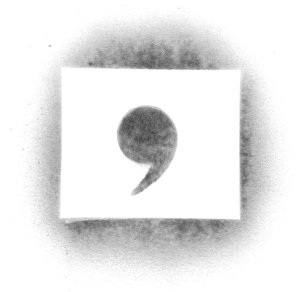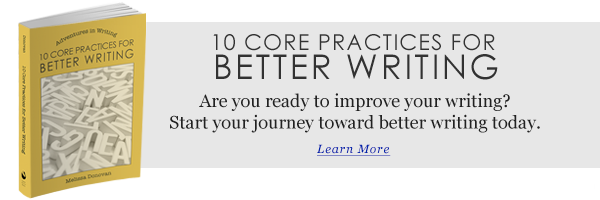|
Punctuation Marks: The Comma by Melissa Donovan | Jan 9, 2025 | Punctuation Marks |
The comma is one of the most widely misused punctuation marks. For such a little punctuation mark, the comma causes an awful lot of confusion. Some writers are too liberal with commas, sprinkling them about like nuts on an ice cream sundae. Other writers hoard their commas and avoid using them whenever possible. Why are these punctuation marks so widely misused? Why are we, collectively, so inconsistent about where we place them? One style guide says use them, another says don’t use them. Even the experts can’t agree! But there are some rules about comma usage that we can all observe and agree on. Punctuation MarksA comma often indicates a pause, but some pauses occur without any assistance from commas. In fact, one of the biggest mistakes people make is to simply place a comma wherever they want the reader to pause. In natural speech we all pause at different places, so this is not a prudent way to decide where your commas go. Instead, let’s look to the rules. Unfortunately, the rules surrounding commas aren’t always clear. Comma placement is often a matter of style and personal (or editorial) choice. One could write an entire book on how to use commas effectively and correctly. Today, we’re just going to look at the basic rules. Commas are mostly used to separate, connect, and set off elements in a sentence: Use a comma to separate three or more elements in a series (including items in a list). The comma that comes before the conjunction in a list is called the serial comma, and it’s recommended but only required if it’s necessary for clarity. A comma should be used to separate coordinate adjectives. Coordinate adjectives are a series of adjectives that modify a single noun (in “the big, black dog,” big and black are coordinate adjectives). Use a comma to separate contrasting elements and if-then statements. Here’s a contrasting statement: I am writing a book, not an essay. Here’s an if-then statement: If I write a book, then I will have to market it. Use a comma before a conjunction to connect independent clauses. An easy way to remember how to identify an independent clause is that it can stand alone as a sentence (a dependent clause cannot). Here’s more information on commas and clauses. Commas should be used to set off introductory elements, short phrases that introduce sentences. Here’s an example with the introductory element in italics: As I was writing, I gave careful consideration to comma placement. Use commas to set off parenthetical elements. A parenthetical element often gives extra but unnecessary information and could be deleted without changing the core meaning of a sentence. Here is an example with the parenthetical element shown in italics: The writer made a list of books she wanted to read, mostly books on grammar, and then proceeded to order them. Parenthetical elements includes names: The writer, Jane, wanted to read a lot of books. Commas are heavily used with quotation marks. They should be placed after a dialogue tag when the dialogue follows the tag and should be placed at the end of the dialogue when the tag comes after the dialogue. The biggest mistake writers make is using a comma for a pause. Some people are actually taught to read their work aloud and then just place commas where all the pauses go (just thinking about it makes me shudder). That is surefire way to get your manuscript all marked up in red by your editor. And if you don’t have an editor, it’s a surefire way to drive readers crazy. Too many punctuation marks in a piece of writing are like rocks in the readers’ shoes. They are distracting and uncomfortable. Too few punctuation marks are like wearing shoes without traction on a slippery floor. Readers will slide all over the place and have trouble following your ideas. Use commas and all other punctuation marks wisely. And keep writing.
13 Comments
Nick Daws on July 12, 2011 at 2:16 am
Excellent advice. I agree, I shudder when I hear people saying, “Put in commas where you would pause for breath.” Apart from anything else, we all pause in different places! Another thing I hate is when I see a comma unnecessarily inserted between the subject of a sentence and its verb, e.g. “Taking pauses for breath, is essential in running but not in writing.” Keep up the good work!
Helen on July 19, 2011 at 12:55 am
Very instructive post. Thanks for sharing. Now all we need to do is get it right. ^_^
Ekaterina on August 1, 2011 at 5:18 am
In my English grammar book (ESL) punctuation was only briefly mentioned. It said something like there’re too few commas in English sentences (compared to Russian), and rules are too vague, so don’t bother at all and skip’em all 🙂
Ashley on November 1, 2011 at 4:47 pm
Melissa, I just found this blog and love it! So helpful. I was wondering, however, if you could break down the use of the comma in this sentence that you wrote: “Commas should be used to set off introductory elements, short phrases that introduce sentences.” I have always been a writer who has gotten by with only using “my ear” for writing, and nothing more, basically flouting the need to really understand grammatical structure and managing to still pull As in all my classes. However, now that I’m out of college and have to rely on myself as the only English teacher I have lying around, commas are starting to come out of the woodwork and confuse me a bit. I understand the general rules for sure, such as listing items, introductory items, combining two independent clauses as long as there is a conjunction thrown in, etc. I just don’t particularly understand why the above sentence is written the way it was. I’m not by any means saying it’s written incorrectly, but if I had written it, I probably would have put a “which are” after the comma, or maybe even a hyphen. I know many writers use commas as you did in this sentence, and simply want to know how it works! !!! 🙂
Vivienne on May 4, 2020 at 2:44 am
I am a member of a critique group and am amazed at how few people (even writers) don’t understand the basic rules of comma usage. No commas between coordinate adjectives is a common sight, and after a name in speech when the named person is being spoken to, such as “John, are you coming?”
Joe Novak on July 25, 2021 at 5:01 am
I noticed many people placing a comma before the word “and”. I thought a comma before the word “and” was totally necessary. Trackbacks/Pingbacks Top Picks Thursday! For Writers & Readers 04-23-2020 | The Author Chronicles - […] explores the easy-to-fix tense problem that might be tripping your readers up, Melissa Donaovan demystifies the comma, and Karstenberg… Submit a Comment This site uses Akismet to reduce spam. Learn how your comment data is processed. (责任编辑:) |


